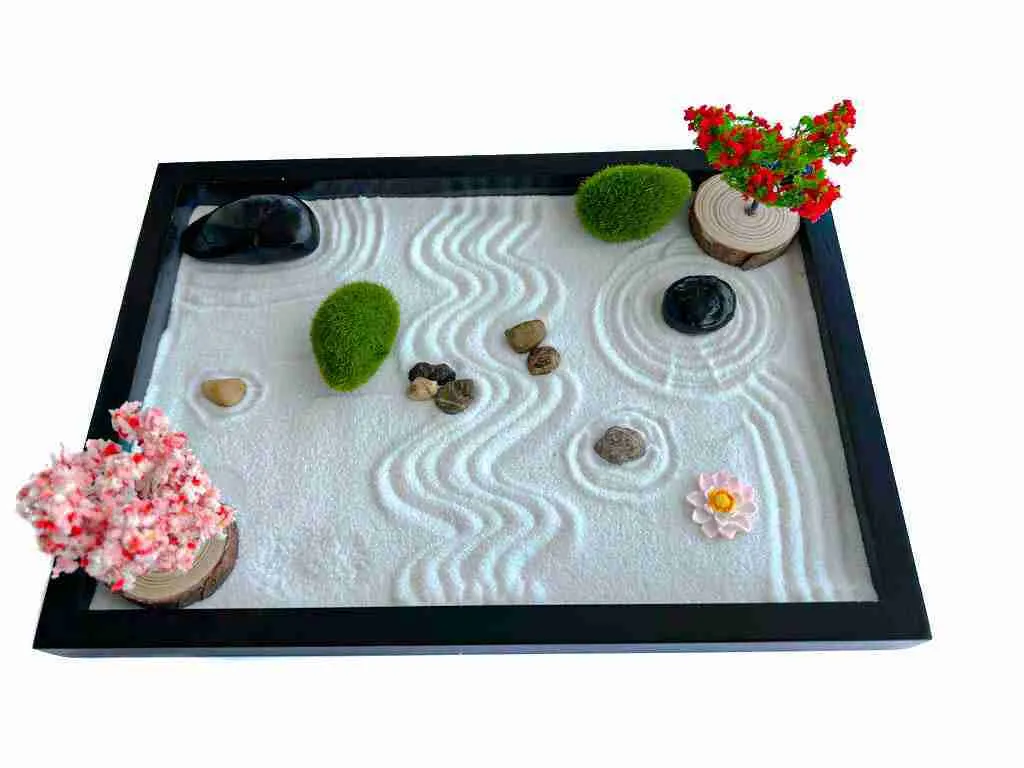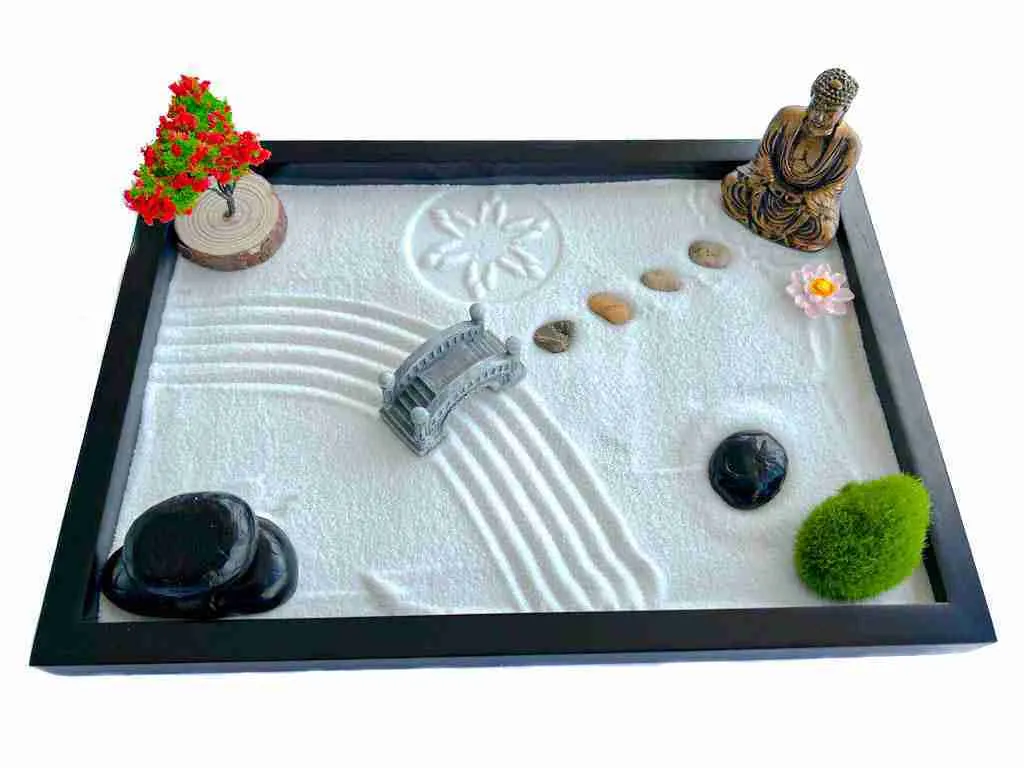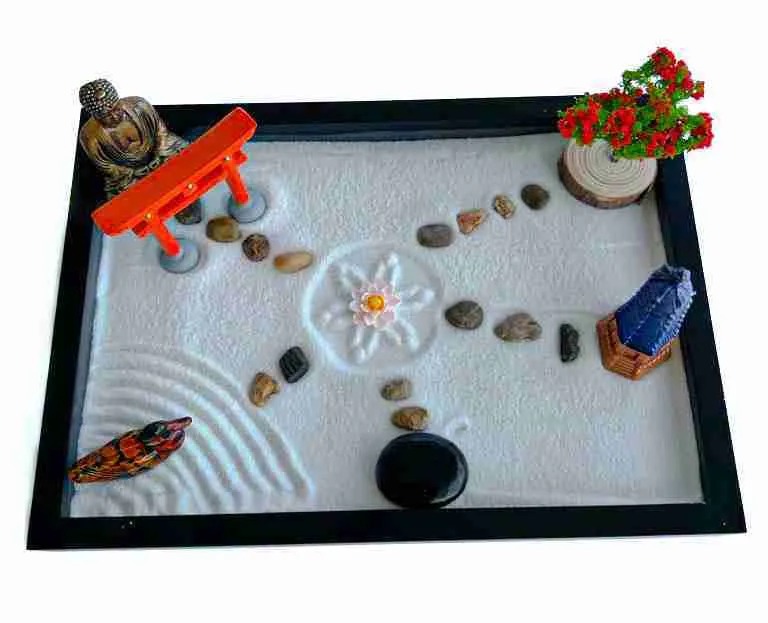Zen gardens were spaces where Buddhist monks used to practice reflective meditation and ponder the teachings of the buddha to achieve tranquility and enlightenment. So it is important to understand the principles of Zen garden design that guide any Japanese lover to create gardens.
Niwa or Japanese garden means “pure place.” We use it to represent a pure and beautiful place that you can always use regardless of the chaotic things in the world or your busy life. Zen gardens are not places to escape and hide from our life troubles, but more as sites to calm our minds and refresh.
Indeed, there are seven Zen principles related to the Niwa or Japanese garden, which we will be discussing today. These principles are Yugen, Shizen, Kanso, Fukinsei, Koko, Datsuzoku, and Seijaku. So, read on to find out you can implement these principles in your backyard Zen garden and even mimic them on your desktop Zen garden.
All of these concepts are interdependent. In other words, they feed off of each other. So no one Japanese philosophy can be used to sum up the Japanese garden or Zen garden completely. The more we can familiarize ourselves with these Zen concepts, the deeper the appreciation we can have for the Japanese garden.
Ultimately, this leads to a more profound experience in the garden where we can absolutely achieve the benefits of Zen meditation. OK! Let’s dive right in.
Yugen (Subtlety)

Yugen is a principle that means hinting at or alluding to the profound but not the obvious. As a principal, you can see Yugen in Zen gardens, where the design encourages you to engage and use your imagination. Implementing the Yugen in your garden helps to arouse curiosity and triggers introspection by making you examine your thoughts and feelings.
Similarly, it makes you use your power of suggestion because it’s not revealing something profound. Still, it’s alluding to or hinting at it. A typical example is viewing a rock path in a zen garden that deliberately twists and turns, keeping you anticipating what’s around the bend.
The implementation of this design is intended to make you use your power of suggestion perhaps as to what the elements represent. Why are the rocks lined up, and why are they leading to the buddha and pagoda, and so on. The rocks represent stepping stones walking paths to quiet areas for Zen meditation.
Shizen (Naruralness)

Shizen is a Zen garden principle that means natural without pretense. Indeed, it combines human creativity and nature, one of the most important benefits of using mini desk Zen gardens. Let me walk you through this principle in greater detail.
Honestly, it allows you to add creative and spontaneous elements to your garden. So, you can further beautify your garden with other elements to suit your Zen meditation needs. But, there must be room for creative intent rather than pretentious or unnatural. Observe the use of natural Japanese garden elements (Stones and rocks, sand, moss, foliage trees, and lotus flower). There is no excessive use of exorbitant items that don’t match the natural surroundings.
Kanso (Simplicity)

Kanso is a Zen principle that emphasizes simplicity. It relates to essential simplicity and cleanliness. Even though the Shizen allows for creative additions, it’s still imperative to keep your garden simple and not too overpopulated with other elements.
Kanso is similar to minimalism in that it eliminates intricate or complex patterns or ideas in the Zen garden design. So, if you are using a desk Zen garden, you may want to limit the use of too many accessories in the garden arrangement.
To summarize, Kanso promotes building or designing your Zen garden with only the essential elements in mind.
Fukinsei (Imperfection)

The next principle we will discuss, the Fukinsei, talks about asymmetry and irregularity as far as Zen gardens are concerned. Let me clarify.
Culturally in the West, we’ve been trained over the years to appreciate equal balance, even numbers, precise mirror images, and so on. We are even stemming back to Greek concepts of symmetry in all things.
However, Eastern ideas of space almost always lean toward an odd division of things, creating irregularities and unevenness. The uneven arrangement is the emphasis of the Fukinsei Zen principle, which allows for inconsistent arrangement of elements in the garden.
For example, rocks that may symbolize mountains may be placed haphazardly in the Zen garden without you trying to mirror them into a pattern. Furthermore, irregularity and asymmetry in Japanese gardens evoke intriguing, engaging, and dynamic beauty. Notice the irregular arrangement of rocks, lotus flower, and moss plant without any intent to mirror them into a pattern.
In conclusion, if you are designing a Japanese garden or perhaps just observing one, take the spaces that intrigue you and see how asymmetry plays a role.
Koko (Austerity)

The Koko principle shows the maturity and stoicism of the Zen elements in a typical Zen garden. Indeed, this principle involves the feeling of endurance, wisdom, and maturity. It shows that the qualities of some of the Japanese garden elements (like the buddha, rocks, lantern, etc.) in the garden enhance with age.
For instance, a buddha sitting out in a backyard Zen garden or a lantern made from concrete discolors over time. This change elaborates the beauty of imperfection, a closely related aesthetic Zen principle. Proudly displaying the history of a stone, the warm bark of a tree, and the moss that blankets the garden floor, are always why the Zen garden embraces Koko.
Datsuzoku (Creativity)

The Datsuzoku principle embraces surprise and breaking from the routine. This same principle pushes you towards appreciating and exploring the unexpected things that come up.
You know, in life, things don’t always go as planned. And this is where creativity should be allowed to fill in the gaps to create something new and exciting with your Zen garden. This design features a raised area to mimic a mountain, a meditating buddha, a stream, and a bridge over it leading to the mountain.
Datsuzoku shows a hidden potential that emerges when we break from convention, routine, and an established tradition. You can design or sketch out a great Japanese garden beforehand. Still, you build it with a great deal of creative versatility. So, you may add other mindfulness elements that spark surprise and stimulate creativity.
Seijaku (Stillness)

The Seijaku encourages solitude and tranquility in Zen gardens. So what’s my point? Seijaku is a feeling that the Japanese garden aims to evoke. According to this principle, a Zen garden is a space of solitude, tranquility, silence, and deep reflection. So your garden should give you a feeling of calm, awareness, and serenity.
On a mini desktop Zen garden, just by raking the sand and maybe concentrating on the sounds produced in the process can achieve these. Additionally, arranging the beautiful accessories (items that symbolize the elements of a traditional Japanese garden) in the sand tray is a great way to free your mind.
If the Japanese garden creates the Seijaku, it can become a place with energetic calmness, movement, open awareness, and no distractions. Observe the undistracted buddha at the center of the garden.
Ultimately, implementing this principle will help you achieve mental clarity, and your creative inspiration will prevail.
Conclusion
Although I have a few favorites of all the seven principles, you need to know that it is necessary to build your Japanese garden with a number of these principles in mind. Having completed this discussion, I believe you now understand and can relate to these philosophies. You’ll now be able to apply them to other areas of design to enjoy the benefits of Zen meditation.




